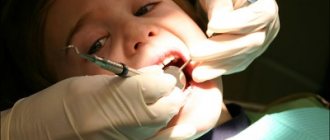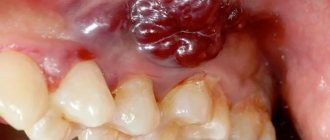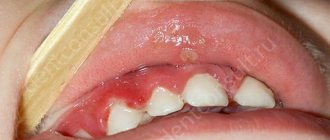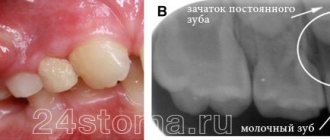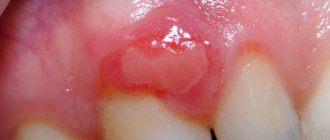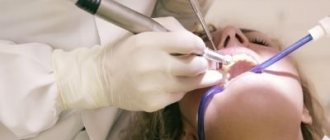Exostosis of the jaw is a benign formation that manifests itself in the form of an osteochondral growth (osteophyte). The protrusions can be single or multiple and are located on the jaw bone. Maxillary osteophytes most often form on the outer (buccal) surface of the alveolar ridge, and exostosis on the lower jaw - from the inside, on the lingual side. A palatal bone growth (palatal torus) is also found.
Exostoses are painless and do not cause any discomfort at an early stage. But as it increases, the formation begins to cause a lot of discomfort - it complicates eating, affects sound pronunciation, interferes with prosthetics, etc. Treatment of osteophytes is only surgical. Removing exostosis on the gum is a low-traumatic operation that takes about an hour. The operation is performed under anesthesia, so the patient does not experience any discomfort. The method of surgical intervention depends on the location of the osteophyte.
Growth on the gum: why it appears and how to treat
A growth has appeared on the gum: what is the cause
Infectious diseases
Non-communicable diseases
Types of growth
Gum cancer
Lump after crown installation
Growth on the gum: how to treat
Which doctor should I contact if a growth appears on the gum?
Normally, the gums have a smooth, pale pink texture. Any change, be it a thickening or a growth, signals problems in the body that cannot be ignored, as they pose a health hazard. Why lumps appear on the gums and how to treat them, we will tell you in the article.
Causes of lumps on the gums
What parents call a “bump” may have different names, different causes, and require different approaches to treatment.
Periodontitis
After hypothermia or acute respiratory viral infection with decreased immunity, purulent processes on the roots of damaged teeth worsen. Then the child develops a painful lump with a white center on the inflamed gum and a very bad breath. This is a small abscess that signals the need to see a dentist for treatment of periodontitis.
Purulent fistula
A child often has a red lump on the gum, up to 1 cm in size - soft and practically painless. This is what a purulent fistula looks like - a passage into the bone from the source of inflammation at the root of the tooth to the gum. Pus periodically flows through this channel. Due to the presence of drainage, such a fistula does not cause discomfort to the baby in the form of pain.
The fate of a tooth can only be decided by a dentist, taking into account the condition of the hard dental tissues, the size of the pathological focus and its effect on the permanent follicle (bud). A purulent lump on a child’s gum disappears after comprehensive treatment of the tooth; in severe cases, it has to be removed.
Periostitis
A lump with pus on a child’s gum sometimes appears near a damaged or previously treated tooth. If the soft tissues around are swollen, hyperemic and painful, then we can conclude that inflammation of the periosteum has developed - periostitis, which is commonly called “flux”. In children, this condition is accompanied by fever and deterioration of well-being. This is a dangerous disease that can develop into osteomyelitis or phlegmon. The help of a dental surgeon is required.
Cyst
Much less often, when a child has a lump on his gum, a cyst is diagnosed - a purulent sac at the top of the root, prone to aggressive growth. With significant magnification, the cyst looks like a very dense rounded bulge on the gum of a normal color. Next to it there is a decayed tooth - the culprit for the formation of the cyst.
This tumor is removed by a dental surgeon. The cyst is not prone to spontaneous resorption.
Hematoma
During teething, a child sometimes develops a blue lump on his gum. This is a bruise - a hematoma that occurs as a result of damage to a blood vessel by an erupting tooth.
To prevent purulent inflammation from developing, the surgeon dissects the gum above the site of blood accumulation under anesthesia.
Localized gingivitis
Trauma to the soft tissue of the gums (sharp bone, sharp object) can lead to infection and inflammation of the wound with the formation of swelling. Complex conservative treatment helps stop the pathological process.
Benign neoplasm
A tumor of the gum or bone is usually discovered by chance, because for a long time the lump on the child’s gum does not hurt or cause concern. Its density varies. Requires surgical removal.
Exostosis
Occasionally, a child near a tooth, usually on the lower jaw on the inside, has a lump on the gum, which is a small bone growth. It does not require any treatment, because... is a feature of the anatomical structure and does not cause any discomfort.
A growth has appeared on the gum: what is the reason?
A lump or growth is a compaction on the gum caused by damage to periodontal tissue, which may appear without any previous signs. Growths appear in people of any age, but mainly in young children, as they unknowingly introduce infection into their mouths. The first thing you need to do when you detect formations in your mouth is to determine the nature of their origin (only a doctor can do this). It comes in two types:
- Infectious. The appearance of cones is caused by the activity of bacteria.
- Non-infectious. Bumps and growths as a result of injury, mechanical or chemical damage.
If a lump has formed in your mouth, you should consult a doctor to rule out possible complications. The doctor will help diagnose the problem and prescribe appropriate treatment.
Treatment methods, how the tumor is removed
Surgical removal
Treatment with epulid is carried out by removing the tumor. An incision is made at a short distance from the epulis, after which it is removed along with the periosteum. If surgery is performed on a giant cell granuloma, an area of bone tissue is also removed. The procedure is carried out using a bur or cutter. If the formation is more than 1 cm, then removal is often carried out under anesthesia with pharyngeal tamponade. The operated area is covered with iodoform gauze. Teeth are removed only when there is great mobility and root exposure. The dentist is the doctor you should contact if you have symptoms of epulis.
After stopping the bleeding, cauterization with alcohol, piocide, thermocautery, or an electrical regulator may be suggested. Treatment of angiomatous epulis can be carried out through sclerotherapy (urethane-quinidine mixture).
Laser treatment
One treatment option is laser removal of the granuloma. The procedure is performed under infiltration anesthesia. Excision of the body of the epulis is performed using a calibrated laser; removal of the body is done with tweezers.
Folk remedies
It is impossible to cure the supragingival tissue with folk remedies (without surgery). Folk remedies will only help in tissue healing. The composition of rinses for quick recovery should be agreed upon with the dentist. Effective recipes:
- Chamomile / sage / eucalyptus / calendula. Two tablespoons of dry plant + a glass of boiling water. Wait until the solution cools slightly. Rinse several times daily.
- A teaspoon of soda + a glass of warm water (prevents suppuration);
- A teaspoon of salt + a glass of hot water. Wait until it cools down (anti-swelling).
Infectious diseases
| Gingivitis and periodontitis Gingivitis is the initial stage of gum disease, often accompanied by the appearance of a red ball-shaped growth near the tooth. The next stage is periodontitis. With it, purulent discharge is observed, and the lump acquires a grayish or beige tint. |
| Granuloma or cyst When pulpitis is advanced, the inflammatory process reaches the apex of the root, where a granuloma forms. Often this process goes unnoticed by the patient, so he is in no hurry to see a doctor. Over time, the pathology can develop into a fistula - a white formation on the gum. |
| Flux Purulent inflammation on the gums occurs against the background of advanced caries or pulpitis, a poorly treated root canal. At the first stage, minor pain appears; on the second - swelling and redness; on the third, the temperature may rise and the cheek may swell; on the fourth – the pain becomes sharp and throbbing, swelling increases. |
Manifestation of hyperplasia
- The color of the enamel changes. Yellow spots appear on it. Discoloration of the enamel may be accompanied by pain, but the tooth still retains its integrity.
- Underdevelopment of enamel, which manifests itself in the form of wavy enamel and furrowed depressions.
- Complete absence of enamel.
The most severe disease is the complete absence of the top layer of enamel, which can manifest itself as: tooth deformation, pain due to temperature changes, pain due to mechanical impact on the teeth.
Risk factors for the development of hyperplasia on permanent teeth:
- Disease of rickets or various infectious diseases.
- Excess of vitamins A, C, D in the body.
- Syphilis disease.
Non-communicable diseases
| Epulis This is a benign formation. It has a stem and a cap. Most often it occurs due to malocclusion, improper prosthetics, and hormonal changes. In the absence of adequate treatment, the tumor can develop into a malignant one. |
| Exostosis A bone growth that occurs against the background of a jaw abnormality - the bone extends beyond its usual boundaries, forming a lump. Most often, the reason lies in a genetic predisposition, less often - as a result of injury or complex tooth extraction. |
| Hematoma As a rule, it is formed as a result of an impact and goes away on its own over time. If there is damage to the tissue, then surgical intervention is necessary. |
Symptoms and signs: what does epulis look like?
In general, epulids in diameter can reach from several mm to 3 cm or more. The color of the supragingival can be reddish-brown, brown, bluish , and also match the color of the gums . Often, ulcers may appear on the surface of a giant cell granuloma, which is most often caused by permanent trauma (sharp edge of a tooth, denture).
The shape of epulid is mushroom-shaped. The formation is located on a stalk, sometimes on a broad base. When pressed, it may move slightly. Epulis can be both soft and hard to the touch. Sometimes the teeth in the area of formation are mobile and slightly displaced.
There are two clinical forms of epulis: benign and malignant. Each of them has its own symptoms. Signs of a benign epulis tumor are:
- Slow growth;
- Diameter up to 2 cm;
- Usually asymptomatic course of the disease.
Malignant supragingival tissue is characterized by:
- Swelling of the gums;
- Rapid growth;
- Soreness;
- Destruction of dental root canals in tissues close to inflammation.
Types of growth
New growths on the gums vary in shape, size, and method of formation.
- Angiomatous growth. A soft, bumpy, pink growth that grows very quickly. Often reappears after removal. This growth is diagnosed in children aged 10-12 years; as a rule, it does not occur in adults.
- A fibrous growth is a gum-colored lump. It grows slowly and does not cause pain, so patients are in no hurry to see a doctor.
- Giant cell growth. A rapidly growing neoplasm of red-blue color, from which serous fluid is secreted. The lump is easy to injure.
How does it occur in children?
In babies, epulis may appear during teething. Most often this is an angiomatous type of disease, but others can occur less frequently. It is advisable to contact a specialist as soon as possible to prevent the danger of tumor growth. Epulis must be removed through surgery. Sometimes the angiomatous appearance is treated with sclerotherapy
Gum cancer
This dangerous neoplasm is worth highlighting separately. Mutation cells begin to divide uncontrollably, which is why a red tumor forms on the gum. The disease progresses quickly and over time can develop into jaw cancer.
What are the symptoms?
- General weakness;
- increased body temperature (37 C°);
- loss of appetite;
- constant drowsiness.
The doctor makes an accurate diagnosis after a detailed examination. As a rule, treatment is long and painstaking. With timely medical intervention, the outcome is favorable.
Diagnosis and treatment
To clarify the diagnosis, the doctor examines the patient. In the early stages of formation, the cyst is not always visible, so an X-ray of the jaw is taken.
There are several methods for treating cysts.
- Drug therapy. Effective at the initial stage, when the cyst is just forming. Aimed at suppressing the inflammatory process, it includes rinsing with antiseptic solutions, taking antibiotics, and local treatment of the affected area of the gums with ointments and gels.
- Surgical intervention. Indicated if the diameter of the cystic formation exceeds 1 cm. During the operation, the doctor can remove the cyst along with the fibrous capsule or install a drainage to drain the purulent contents.
Growth on the gum: how to treat
The treatment plan is developed by the doctor based on the nature of the growth, so in no case should you self-medicate. It is important to understand that if you do not contact a specialist in a timely manner, serious complications can arise.
If the cause is an infection, then it must be removed. In case of periodontal inflammation, professional oral hygiene is performed. If the cause is periodontitis and complicated pulpitis, then first the lump is opened and pus is pumped out of it, and then conservative or surgical treatment is carried out.
If there is no pain, for example, with epulis or ecostosis, then the decision about surgical intervention is made together with the patient.
How do stones form on teeth?
The main factor in the formation of tartar is certainly the presence of soft microbial plaque on the teeth. Its formation begins within 1-2 hours after brushing your teeth, and this process is accelerated many times over in the presence of food residues in the oral cavity (if you did not brush your teeth immediately after eating). In parallel with the increase in the amount of dental plaque, its mineralization also occurs, i.e. it begins to become saturated with calcium salts contained in saliva. Partial mineralization of plaque occurs on average within 10-16 hours from the moment of its appearance.
Thus, if your oral hygiene is poor, it only takes 1-2 days for a thin layer of partially mineralized plaque to form on your teeth. It will be firmly attached to the surface of the teeth, and it will no longer be possible to remove it with a toothbrush and toothpaste. In places where partially mineralized plaque is deposited, the tooth enamel becomes rough, which facilitates the rapid attachment of new portions of plaque and its mineralization. This is how tartar forms.
Looking at the photo above (Fig. 1-6), please note that the formation of tartar occurs primarily in the area of the necks of the teeth, i.e. exactly in those places where soft plaque accumulates after eating. The second favorite location is periodontal pockets (also called periodontal pockets). The formation of such pockets occurs during periodontitis.
Factors contributing to the formation of tartar:
The rate at which tartar forms varies from person to person. In addition to the obligatory presence of soft plaque, a number of other factors can also affect the rate of formation of tartar (but they are only predisposing). Such factors include –
- the predominance of soft, overly processed foods in the diet, as well as a large amount of easily digestible carbohydrates,
- frequent snacking between meals, followed by poor oral hygiene,
- smoking,
- increased salivation,
- changes in the volume of secretion and chemical composition of the gingival fluid (occurs when the patient has gum inflammation - gingivitis or periodontitis),
- and, of course, poor/irregular oral hygiene, refusal to use dental floss to clean interdental spaces, use of low-quality hygiene products for hygiene (for example, old brushes with fluffy bristles), etc.
Causes
Reasons for the formation of growths:
- inflammatory, infectious processes, purulent accumulations;
- mechanical impacts, injuries causing bone destruction, jaw displacement and other damage;
- deviations of row segments, formation of nodular hardenings;
- disorders of the endocrine system, hormonal levels.
One of the reasons for the development of pathology is complex tooth extraction. Often, when a wound heals, the tissue around it becomes overgrown with moving areas. If done incorrectly, compactions may appear and exostosis will gradually develop.



